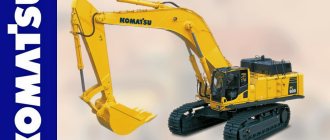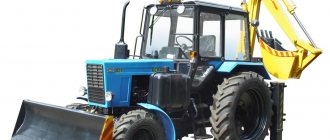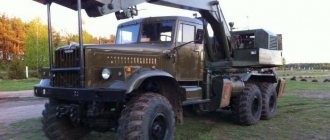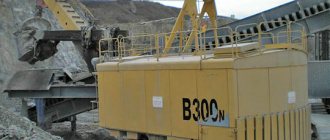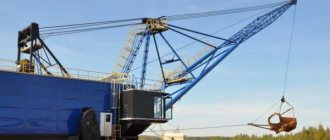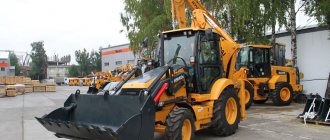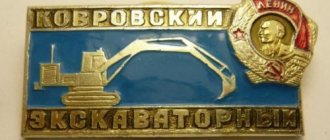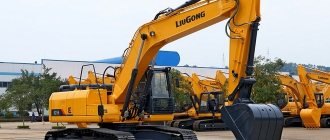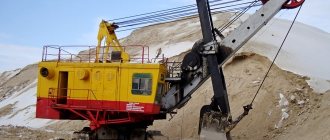| The EO-4112A excavator (dragline) is intended for excavation work in light and heavy soils of categories I-IV. The excavator can be equipped with various types of replaceable equipment and perform the following types of work: - dragline - digging canals, trenches, loading soil into vehicles and dumps, using it for reclamation work; — backhoe – loading into vehicles, digging canals, pits, trenches, etc.; — with a straight shovel – quarrying, loading soil into vehicles and dumps; — with a grab – loading and unloading bulk materials, digging pits, wells, etc. |
Definition and purpose
An excavator is a machine for digging soil. The working body is a bucket. It can be of different designs. To expand functionality, replaceable equipment is used: crane (hook), hydraulic hammer, pile driver, etc. In addition to the “classic” equipment, there are backhoe loaders and mini-excavators. According to the principle of operation, excavators are divided into the following types:
- Cyclic (cyclic action). This includes single-bucket machines.
- Continuous action. This group includes: multi-bucket rotary, with a front cutter, trench with a toothed chain.
- Vacuum.
Below we consider only the first category - an excavator with a bucket. By purpose, the following classification is adopted:
- Construction. Bucket volume up to 3 m3. They are mainly used for excavation or loading and unloading work. Most models are universal (that is, they have 4 or more types of interchangeable equipment).
- Career. They are equipped with working equipment from 2 m3 to 8 m3. They are used in quarries for the development of rock, coal or ore deposits.
- Overburden. Bucket capacity from 6 m3. They are used when it is necessary to remove (open) the top layer of rock, under which useful minerals lie. A distinctive feature is an elongated boom and greater power.
Special equipment is included in a separate group. This includes peat, destructive, tunnel, rescue, underground, railway, underwater, swamp and other models. They require special equipment and attachments.
General characteristics of dragline EO-4112
Dragline EO-4112 stands out among similar special equipment. There are a number of positive qualities that are worth knowing about.
- All mechanisms are provided with easy access, which in turn facilitates maintenance of the equipment as a whole;
- Even in remote work conditions, it is possible to carry out various types of repair work;
- Suitable for work even in difficult conditions;
- Buckets of different sizes can be used to perform different jobs;
- Low consumption of fuel and other consumables makes the dragline a very economical model.
Structural differences of the model
The EO-4112 excavator is a full-rotary type of equipment. It features a single-motor drive and flexible suspension work equipment. A support stand is installed on this rotating platform. For the EO-4112 model, a mechanical drive of 4 and 5 size groups is used. The dragline of this model is considered the basic option. On its basis, other models were subsequently developed that met all modern requirements. Model EO-4112 can be equipped with different types of units to perform a variety of work.
Attachment options:
- backhoe - used to load and unload various materials. With its help, pits and trenches can be developed;
- a straight shovel is used in the quarry industry to move and dump soil;
- dragline is indispensable for digging a pit and loading work, in some cases it can be used for reclamation work;
- The grab is used when working with various bulk materials.
This versatility makes draglines popular in various industries.
Specifications
If you need to perform work in difficult climatic conditions and on different soils, preference should be given to the EO-4112 dragline, or use the EO-5111 dragline. Before you buy an EO-4112 excavator, you should review the technical specifications and become familiar with them more thoroughly.
- engine type - D 180.121-6;
- platform rotation - 5.8 rpm;
- surface pressure - 60 kPa;
- fuel tank volume - 200 liters;
- maximum unloading height – 6.3 m;
- maximum digging depth – 11 m;
- radius of action (digging) – 15.3 meters;
- specific fuel consumption - 215 g/kW.hour;
- lifting angle of the dragline during movement - 22 degrees;
- compressor - two-cylinder, single-stage piston;
Very high performance and reliability of all working units allow the equipment to be used for a long time. In this case, breakdowns occur extremely rarely. The main thing is to carry out technical inspections and scheduled maintenance in a timely manner. Distinctive characteristics also include fairly simple operation of the excavator. Drawing conclusions, it can be noted that buying the EO-4112 model means providing yourself with high-quality special equipment for a long time.
Control Features
A crawler dragline consists of a bogie, a cabin and a working body. The trolley, in turn, consists of a bent profile and a cast running frame. Tracks are made up of links that are attached to a track chain. The operator's cabin is characterized by a high level of thermal insulation. The cabin of the Hyundai R210LC-7 excavator also features comfortable conditions. It is located on rubber shock absorbers. Thanks to this, the excavator operator can spend a long time in the cabin and perform work without losing productivity. A comfortable anti-vibration chair reduces stress on your posture. For comfort, a fan and heating unit are also installed in the cabin. This allows you to control and create the required temperature in the cabin at any time of the year.
Electro-pneumatic control of working bodies makes it possible to quickly switch from one operation to another.
Before starting work for the first time, you should undergo safety training. If malfunctions or various problems occur in the operation of the dragline, it is worth carrying out an inspection or sending the equipment to a specialized center for repair work. If you have your own mechanics, then repair work can be done at home. Spare parts and necessary consumables can be easily purchased in specialized stores.
History of creation
The debut copy of this earth-moving equipment was assembled in 1970. After passing comprehensive tests, serial production of EO-4121 excavators was launched in 1974 at the Kovrov Excavator Plant, Vladimir Region.
Kovrovsky Excavator is the manufacturer of the first excavator in our country and, in general, one of the oldest enterprises in the entire domestic mechanical engineering industry. It was founded on the production base of railway workshops operating since 1861 at the Kovrov station of the Moscow-Nizhny Novgorod railway.
In 1930, the workshops were transformed into a plant for the repair of foreign-made earth-moving machines. And already on April 21, 1931, the first Soviet excavator in history was built here, which became the ancestor of the extensive family of Kovrovets excavators.
Both in Soviet times and to this day, the Kovrov Excavator Plant is one of the most advanced and leading domestic enterprises in this industry. Over the years of operation, about one hundred thousand units of earth-moving equipment rolled off its assembly line, and the number of different models and modifications reached 64 types. The EO-4121 excavator lasted on the factory assembly line until 1991, and its direct “descendants” were the EO-4124, EO-4125, EO-4224, MTP-71 (“EO-71”) models. 4221"). The modern embodiment of the EO-4121 concept can be called the EO-4225 excavator - a more progressive and advanced version.
Today Excavatorny specializes in the production of full-rotary hydraulic crawler excavators: “KiT-26”, “EO-4225A-071”, “EO-4225A-061” with a full range of attachments. It also produces forestry and loading equipment.
Options for purchasing the EO-4112 model
The price for the EO-4112 excavator can be completely different. For used models of earlier years of production, the cost will be within 800,000 rubles. As for models that were produced in a later period and are characterized by minimal mileage and excellent technical condition, the cost can increase up to 3 million rubles. The purchase of this equipment is justified by its technical indicators and high performance in different conditions. If you need to perform one-time work, then it is more advisable to rent equipment for a certain period of time. The cost of renting the EO-4112 model today will vary within 12,000 rubles for an 8-hour working day. Costs may increase when transporting equipment to the job site. Knowing all the prices, you can determine which option is best suited in a particular case.
Equipment grab
| Specifications | ||
| Bucket capacity, m3 | 0,65 | |
| Boom length, m | 10,0 | |
| Maximum digging depth, m | 6,0 | |
| Maximum unloading height, m | 7,6 | |
| Operating weight, t | 23,4 | |
| Maximum digging radius, m | 8,0 | |
| Operating cycle duration, s | 23,5 | |
Advantages of the EO-4112A-1 excavator over the EO-5116-1 excavator (Kostroma Excavator Plant)
Weight of excavator EO-4112A, t……24.6 Weight of excavator EO-5116-1, t……34.75 Average specific pressure on soil EO-4112A, kgf/cm2……0.62 Average specific pressure on soil EO- 5116-1, kgf/cm2……0.83 Duration of the operating cycle of EO-4112A, sec…….19 Duration of the operating cycle of EO-5116-1, sec…….23 Maximum speed of movement of EO-4112-1, km/h ……4.3 Maximum travel speed of EO-5116-1, km/h……1.8 Specific fuel consumption of EO-4112A, l/hour……19 Specific fuel consumption of EO-5116-1, l/hour……22 ,3
A comparative analysis of the technical characteristics of excavators shows that the EO-4112 A-1 excavator, having lower ground pressure and higher travel speed, is much more maneuverable. Due to lower fuel consumption, better transportability is ensured.
Experience in operating excavators shows that the EO-4112A-1 excavator's annual soil production is 10-12% greater than that of the EO-5116-1 excavator. The presence of a torque converter in the EO-5116-1 excavator entails additional costs for hydraulic oil and, as a result, the excavator requires higher operating costs.
In addition, the low-speed diesel engine installed on the EO-4112A-1 excavator has a longer service life compared to the high-speed diesel engine installed on the EO-5116-1 excavator.
Crawler excavator EO-4112A-1 - technical characteristics
| content .. 10 11 12 13 14 15 .. The EO-4112A excavator (dragline) is intended for excavation work in light and heavy soils of categories I-IV. The excavator can be equipped with various types of replaceable equipment and perform the following types of work: - dragline - digging canals, trenches, loading soil into vehicles and dumps, using it for reclamation work; — backhoe – loading into vehicles, digging canals, pits, trenches, etc.; — with a straight shovel – quarrying, loading soil into vehicles and dumps; — with a grab – loading and unloading bulk materials, digging pits, wells, etc. Technical characteristics of EO-4112A-1 with draglineTechnical characteristics, engine | |
| Power at 850+25 rpm | 66(99) |
| Specific fuel consumption, g/kWh | 215 |
| Shaft rotation speed at idle speed, rpm | 920 |
| Main engine tanks | |
| Starting motor housing, l | 1,9 |
| Lubrication system, l | 27 |
| Water cooling system (with radiator), l | 75 |
| Starting engine fuel tank, l | 8 |
| Compressor | piston single-stage two-cylinder |
| Maximum working pressure, MPa | 0,7 |
| Electrical equipment | |
| Current - constant | |
| Rated voltage, V | 12; 24 |
Specifications
| Boom length, m | 10 | 13,7 | 15 |
| Bucket capacity, cubic m | 0,65 0,8 1 | 0,65 0,8 | 0,65 0,8 |
| Maximum digging depth, m | 7,3 | 10,0 | 11,0 |
| Maximum unloading height, m | 3,5 | 5,3 | 6,3 |
| Maximum digging radius, m | 11,1 | 14,3 | 15,3 |
| Operating cycle duration, s | 19,5 | 19,5 | 19,5 |
| Operating weight, t | 22,3 | 24,2 | 24,5 |
| Maximum platform rotation speed, r/s | 5,8 | ||
| Maximum travel speed, km/h | 3,5 | ||
| Lifting angle of the excavator when moving, degrees | 22 | ||
| Permissible excavator tilt angle, degrees | 5 | ||
| Pressure on the supporting surface, kPa | 60 | ||
| Main filling containers | |||
| Swivel frame housing, l | 30 | ||
| Consumable fuel tank, l | 70 | ||
| Main fuel tank, l | 200 |
content .. 10 11 12 13 14 15 ..
zinref.ru
Single-bucket, full-rotary, universal, crawler-mounted, multi-bearing type, on rigidly mounted support rollers. The main difference between the EO-4112A excavator and the previously produced EO-4111G model is the use of a tractor-type caterpillar drive with a lantern gear. The EO-4112A-1 model retains the old type caterpillar drive, with ridge (cam) engagement. The excavator crawler carriage is a rigid welded structure made of a bent profile and a cast running frame. The caterpillar tracks are assembled from profile tracks (links) mounted on a caterpillar chain. The drive chains and caterpillar tracks are tensioned using hydraulic cylinders. The mechanisms of the turntable are maximally unified with the mechanisms of the turntable of the E-652B, EO-4111V and EO-4111G excavators. The thermally insulated cabin is installed on rubber shock absorbers, it is equipped with a comfortable anti-vibration seat for the operator, equipped with a fan, a windshield wiper, and a heating unit to maintain normal temperature in cold weather. The control of the executive bodies of the excavator is electro-pneumatic. A light display is installed in the cabin, on which the most important engine parameters are displayed to monitor serviceability. An audible signal notifies you of problems at controlled points. Good visibility and convenient location of controls create good working conditions for the driver. Easy access to components and mechanisms is provided. Electro-pneumatic control ensures smooth execution of all work operations. The excavator operates at temperatures from -40° to +40° C. The main advantages of the excavator: reliability in the operation of components and mechanisms, high productivity, high maneuverability and good stability, low pressure on the ground, ease of operation and maintenance, control of the vital parameters of the excavator electronic system, the ability to use various types of replaceable equipment.Technical characteristics of the EO-4112A excavator
Diesel, brand
| D-160B-6 | |
| Diesel power, kW/hp | 66 / 90 |
| Replaceable work equipment | straight and reverse shovel, dragline, grab, crane |
| Mechanism control | pneumatic |
| Travel speed in first/second gear, km/h | 2,4 / 4,3 |
| Turntable rotation speed in 1st/2nd gear, rpm | 3,33 / 5,89 |
| Overcome slope of the track, degrees | 22 |
| Working pressure of the pneumatic control system, MPa | 0,7 |
| Average ground pressure, kPa | 65 |
| Traction force on tracks, kN | 98 |
| Overall dimensions, mm | 5300x3100x3400 |
| Excavator weight (without working equipment), t | 20,37 |
Parameters when working with various replaceable equipment
| Backhoe | straight shovel | Dragline | Grab | |||||
| Boom length, m | Boom length, m | |||||||
| Curved Arrow | Station wagon | 10 | 13,7 | 15 | 10 | 13,7 | ||
| Bucket capacity, m3 | 0,8 | 0,65 | 0,75 | 0,65; 0,8; 1,0 | 0,65; 0,8 | 0,6 | 0,65 | 0,65 |
| Max. digging depth (height), m | 6,8 | 5,8 | 7,9 | 7,3 | 10 | 11 | 6 | 8 |
| Maximum unloading height, m | 6,1 | 3,5 | 5,6 | 3,5 | 5,3 | 8 | 7,6 | 9 |
| Maximum digging radius, m | 10,1 | 9,2 | 7,9 | 8 | 10 | |||
| Operating weight, t | 23,7 | 23,55 | 24 | 22,3 | 24,2 | 24,5 | 23,4 | 25,3 |
Dimensions in meters
| A | Distance from the boom axis to the excavator rotation axis | 1 |
| R | Radius described by the rear part of the excavator turntable | 3,405 |
| B | Excavator overall width | 3,100 |
| B1 | Track width | 0,600 |
| B2 | Track width | 2,960 |
| D | Height at the bottom edge of the turntable | 1,043 |
| D1 | Clearance | 0,354 |
| L | Track length | 3,820 |
| H | Height to arrow heel axis | 1,640 |
| H1 | Height of the two-legged stand block | 3,400 |
| H2 | Track height | 0,974 |
| H3 | Height to top of cabin | 3,054 |
Technical characteristics of the excavator when working with a dragline
| Bucket capacity, m3 | 0,65 | 0,8 | 1,0 | |
| Traction rope force, tf | 5,64 | |||
| Lifting rope force, tf | 5,14 | |||
| Hoisting rope speed, m/s | 1,08 | |||
| Traction rope speed, m/s | 0,98 | |||
| Cycle duration when working in a dump with a rotation of 135° in Cat III soils, at an average digging depth, s | 19,1 | |||
| Average specific ground pressure, kgf/cm2 | 0,64 | |||
| Excavator structural weight, t | ||||
| with a 10 m boom | 21,9 | |||
| with a boom length of 13.7 m | 24,6 | |||
| Boom length, m | 10 | 13,7 | ||
| Boom angle, a | 30° | 45° | 30° | 45° |
| Maximum unloading height, m | 3,5 | 5,5 | 5,3 | 8 |
| Digging depth during side passage, m | 4,4 | 3,8 | 6,6 | 5,8 |
| Digging depth at end pass, m | 7,3 | 5,5 | 10 | 7,6 |
| Maximum digging radius, m | 11,1 | 10,2 | 14,3 | 13,2 |
| Maximum unloading radius, m | 10 | 8,3 | 12,5 | 10,4 |
Technical characteristics of the excavator when working with a grab
| Bucket capacity, m3 | 0,65 |
| Bucket lifting speed, m/s | 0,75 |
| Average specific ground pressure, kgf/cm2 | 0,65 |
| Cycle duration when turning 90° at an average digging depth, s | 23,5 |
| Excavator structural weight, t | 22,4 |
| Boom length, m | 10 |
| Overall width of open grab, m | 2,4 |
| Overall height of open grab, m | 2,9 |
| Minimum boom angle, degrees | 45 |
| Maximum digging depth, m | 6 |
| Maximum unloading height, m | 7,6 |
| Maximum digging radius, m | 8 |
Technical characteristics of the excavator when working with a straight shovel
| Bucket capacity, m3 | 0,75 |
| Maximum force on bucket teeth, tf | 11,3 |
| Maximum force on the “Pressure-return” handle, tf | 11,5 / 8,2 |
| Cycle duration when working in transport with a 90° turn on category IV soils at the design face height, sec | 15 |
| Average specific ground pressure, kgf/cm2 | 0,64 |
| Structural weight, t | 23,4 |
| A capacitive bucket can be used. 0.8 m3 when developing soils of categories I - III | |
| Boom length, m | 5,5 |
| Handle length, m | 4,5 |
| Digging depth below parking level, m | 1,5 |
| Minimum digging radius at ground level, m | 2,8 |
| Maximum digging radius, m | 7,9 |
| Maximum unloading radius, m | 7,2 |
| Unloading radius at the highest unloading height, m | 5,4 |
| Maximum digging height, m | 7,9 |
| Maximum unloading height, m | 5,6 |
| Unloading height at the smallest unloading radius, m | 2,7 |
Technical characteristics of the excavator when working with a backhoe
| Bucket capacity, m3 | 0,65 | 0,8 |
| Bucket width, m | 1,16 | |
| Traction rope speed, m/s | 0,98 | |
| Hoisting rope speed, m/s | 1,08 | |
| Boom length, m | 5,9 | |
| Handle length, m | 3,02 | |
| Maximum digging depth, m: | ||
| trenches | 6,8 | |
| pit | 4,64 | |
| Initial unloading height, m | 2,35 | |
| Final unloading height, m | 5,3 | |
| Maximum digging radius, m | 10,00 | |
| Initial unloading radius, m | 5 | |
| Final unloading radius, m | 8,1 | |
| Cycle duration, s | 18,1 | |
| Structural weight, t | 23,85 |
Advantages and disadvantages
Most models have:
- Low cost. They are productive and do not require large operating costs.
- High maintainability.
- Mobility, high cross-country ability.
- They work in winter and hot weather without interruption.
- Not afraid of dust.
- They have or can be equipped with interchangeable attachments, which expands their versatility.
Disadvantages include:
- weak hydraulic hoses;
- Difficulty starting engines in cold weather;
- difficulty in mastering management.
Specifications table
The technical characteristics of excavators are scattered over a very wide range. This is due to the fact that the machines have different purposes and are designed for different volumes of work. The main technical characteristics are summarized in the table:
The volume of the bucket is given geometrically. The actual amount of soil removed during operation, due to the “cap”, is 15-30% higher. On machines that are planned to be used on heavy soils, buckets of a smaller volume than necessary for this group are installed.
In addition to the parameters indicated in the table, the performance of an excavator depends on its design and technical condition. And also on factors not directly related to the unit: proper organization of work, driver qualifications, soil density, etc.
Dragline equipment
Main consumer properties of the EO4112A-1 excavator with dragline equipment:
- Easy to operate and maintain, easy access to components and mechanisms is provided;
- Reliability in the operation of components and mechanisms;
- Repairable in field conditions;
- The mechanical drive of the working equipment and low ground pressure (0.53-0.56 kgf/cm2) allow the excavator to be used in difficult operating conditions (sand, marshy soils, at temperatures from –40° to +55°). Under the above operating conditions, hydraulic excavators often malfunction;
- Due to the larger bucket volume, the daily production rate is 2.5-3 times higher than that of hydraulic excavators weighing up to 25 tons with backhoe equipment with an extended handle;
- Ability to perform reclamation operations: digging and cleaning canals, trenches, filling protective dams, cleaning and deepening rivers, loading soil into vehicles and dumps;
- The thermo-noise-vibration-insulated cabin is installed on rubber shock absorbers, it is equipped with a comfortable anti-vibration seat for the operator, equipped with a windshield wiper, and a heating unit to maintain normal temperature in cold weather. The cockpit is equipped with instruments to monitor the most important engine parameters;
- Cost savings for the buyer due to lower costs for fuels and lubricants, unlike hydraulic excavators;
- The warranty period for this type of excavator is 12 months
Specifications
General parameters of the EO-4121 excavator:
- Wheel formula – 4 by 4;
- Length without bucket – 4.9 m, width – 2.9 m, height – 3.060 m;
- Track base – 2,750 m;
- The size of the caterpillar track is length 2.93 m, belt width 0.58 m;
- Platform revolutions per minute – 6;
- Platform width – 3 m;
- Ground clearance under the turntable – 942 mm;
- The height of the arrow heel axis is 2.02 m;
- The distance from the heel axis to the axis of rotation is 520 mm;
- Weight with a front shovel - 19.87 tons, with a backhoe - 20.9 tons, with a grab - 20.9 tons, with a loader - 19.87 tons;
- Travel speed – 2.8 km/hour.
- The surmountable slope of the path is 22 degrees;
- Productivity – up to 150 cubic meters per hour.
Characteristics of the working bucket model:
- Capacity – from 0.65 to 1.5 cubic meters;
- Digging radius – 9.2 m (backhoe); 7.25 m (straight shovel); 8.9 (grab); 3.75 m (by loader);
- The radius described by the tail part of the platform is 3.13 m;
- Digging depth – 5.8 m (backhoe); 3.6 m (straight shovel); 3.2 m (grab);
- Loading height – 5 meters;
- The force on the bucket teeth is 14,200 kgf;
- Cycle time – with straight shovel and loader: 16 seconds; with backhoe: 20 seconds.
Depending on the type of bucket used, these data may vary slightly. The specific ground pressure indicator for EO-4121 brand excavators is 63.6 kPa, the minimum cycle duration at a 90-degree rotation angle is 18 seconds.
Engine
The EO-4121 excavators were equipped with diesel engines of the A-01 and A-01M brands from the Altai Motor Plant, Barnaul. It is simple in design and maintenance, unpretentious, high-quality motor, which is still produced and installed on a number of agricultural, industrial and forestry tractors, and on road construction equipment.
A six-cylinder four-stroke naturally aspirated diesel engine of type “A-01” is equipped with a two-valve gas distribution mechanism on each cylinder. The arrangement of the cylinders is in-line, vertical. The mixture formation method is direct fuel injection. Cooling method – liquid.
Engine A-01
In the design of the motor, special cast iron liners were used, with the working surface treated by flat-top honing; pistons with a three-ring set of piston rings, optimized side surface profile and graphitized skirt; crankcase with increased strength and improved cooling of cylinder liners. The engine has a solid service life (up to 12,000 operating hours).
- Cylinder displacement: 11.15 l;
- Rated power: 99 kW, or 135 hp;
- Cylinder operating order: 1-5-3-6-2-4;
- Cylinder diameter: 130 mm;
- Piston stroke: 140 mm;
- Compression ratio: 16.5 (+/- 0.5);
- Rated crankshaft rotation speed – 1700 rpm;
- Nominal torque reserve factor – 25%;
- Specific effective fuel consumption at rated power – 221 g/kWh (163 g/hp-h);
- The relative oil consumption for waste is 0.3% of fuel consumption.
The A-01 engine drives two hydraulic pumps with adjustable output. Both pumps are installed in the same housing and driven through a gearbox. Additionally, a pre-start heater “PZHB-300V” is installed, which makes it easier to start the engine in conditions of especially low temperatures.
Chassis
The chassis is a tracked mechanism in which each track receives force from an individual hydraulic motor through a gearbox. The hydraulic cylinder is responsible for tensioning the track. The design of the chassis is equipped with widened links, which can significantly reduce the pressure on the ground. This option is intended for use on waterlogged and weak soils.
The turning mechanism includes a three-stage gearbox, a rotary gear and a hydraulic motor, consisting of safety and distribution equipment, a double pump and executive working elements. The performance of pumps mounted in a single housing can be adjusted. They themselves are started by diesel engines through a transfer gearbox. On the turntable behind the cab there are spool distribution blocks.
The crawler trolley of the EO-4124 excavator is equipped with tracks made of cast tracks with lantern gears. Nowadays, such a solution is no longer used, or is used quite rarely. However, it provides excellent reliability and wear resistance of excavator tracks. As a rule, the service life of tracks of this design is two to three times longer compared to conventional tracks.
Hydraulic system
The hydraulic drive of the excavator includes: a double pump, distribution and safety equipment, executive working elements. Hydraulic pumps of adjustable capacity, mounted in a single housing, are driven by a diesel engine through a transfer gearbox. The spool distribution blocks are mounted on a turntable behind the cab. The pressure of the working fluid in the hydraulic circuit of the drive of the working parts of the excavator was ensured at the level of 250 kg/cm, which for those times was a record figure for both the Soviet Union and Europe.
Equipment straight shovel
| Specifications | ||
| Bucket capacity, m3 | 0,75 | |
| Maximum digging height, m | 7,9 | |
| Maximum digging radius, m | 7,9 | |
| Maximum unloading height, m | 5,6 | |
| Operating weight, t | 24,0 | |
| Maximum unloading radius, m | 7,2 | |
| Operating cycle duration, s | 15,0 | |
Excavators EO
EO excavators are part of municipal construction equipment. The machines are used not only in the countries of the former USSR, but also abroad. EO excavators are suitable for municipal construction work due to their high efficiency and versatility. Now the machines are used not only by state enterprises - they are in the public domain. The model range is also valued by owners of construction companies for cheap repairs of EO excavators and a large selection of replacement parts. Production continues today - two types of EO excavators are rolling off the assembly lines of the largest factories (the main supplier-manufacturer of EO excavators is Ural-MASH):
- Tracked vehicles;
- Wheeled vehicles (in limited quantities).
Modifications
A total of two modified versions of this crawler excavator were produced, namely EO-4121A and EO-4121B. The most popular version of them was the second modification.
The EO-4121B differs from the basic excavator in having a reinforced boom, due to which the scope of application of the equipment has been expanded. The machine began to be used for quarrying and loosening rocks. In addition, this change allowed the excavator to work with very heavy weights, which is also a big plus.
EO-4121B
The machine can use a hydraulic breaker, pincer-type gripper, as well as loosening equipment in the working process. All this allows the equipment to carry out stripping work in frozen and rocky soils.
The operator's cabin is located on rubber shock absorbers, which absorb strong vibrations and shocks that occur during operation. The cabin also has an adjustable seat and transport air conditioning (installed optionally).
